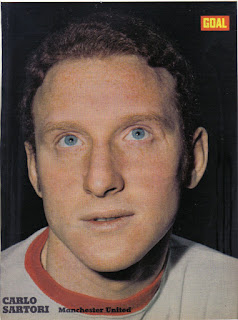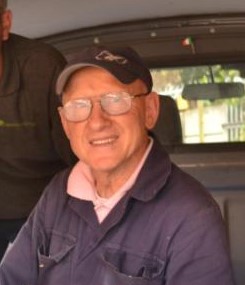Italian was first foreigner to play for Manchester United
 |
| Italian-born Carlo Sartori in action for Manchester United |
Carlo Domenico Sartori, the first footballer from outside
Great Britain or Ireland to play for Manchester United, was born on this day in
1948 in the mountain village of Caderzone Terme in Trentino.
The red-haired attacking midfielder made his United debut on
October 9, 1968, appearing as substitute in a 2-2 draw against Tottenham Hotspur
at the London club’s White Hart Lane ground.
On the field were seven members of the United team that had
won the European Cup for the first time the previous May, including George Best
and Bobby Charlton, as well as his boyhood idol, Denis Law, who had missed the
final against Benfica through injury.
Sartori, who made his European Cup debut against the Belgian
side Anderlecht the following month, went on to make 56 appearances in four
seasons as a senior United player before returning to Italy to join Bologna.
Although they dominate the Premier League today, players
from abroad were a rarity in British football in Sartori’s era and United did
not have another in their ranks until they signed the Yugoslav defender Nikola
Jovanovic from Red Star Belgrade in 1980.
Jovanovic, in fact, was the first United player to be signed
from an overseas club, Sartori having grown up in Manchester after arriving in
the city with his family as a 10-month old baby.
 |
| Sartori made 56 senior appearances for United before joining Bologna |
They lived at first in the Ancoats area to the northeast of
the industrial city, which at the time had a large Italian community.
Later, they would move a little further out of the city to
Collyhurst, where his father established a knife-sharpening business that still
thrives today, with clients in Liverpool as well as Manchester, and which would
later provide Carlo with a living.
The young Sartori caught the eye as a schoolboy and a number
of professional clubs began to monitor his progress. Everton, Burnley and West Bromwich Albion all
expressed an interest in signing him, and he had a trial with Manchester City, before
United sent Joe Armstrong, their chief scout, to meet him and his parents at
their home and offer him an apprenticeship.
His career made good progress while Matt Busby was United
manager but began to wane after the legendary Scottish boss retired. In 1973
came the opportunity to play in Italy for Bologna, although in order to return
to Italy he had to accept a period of compulsory national service.
Even so, Sartori was able to keep his football skills in
order by turning out for the Italian Army team, with whom he won the World Military
Cup. Though he had to content himself initially
with being on the fringes at Bologna, he still picked up a medal in his first
season as a member of their victorious Coppa Italia squad.
He went on to play for a number of clubs in Italy, including 100 appearances for Lecce, before finishing
his career, appropriately, with Trento, which meant he was able to rediscover
his roots, having been born just 30km (19 miles) away.
 |
| Sartori, pictured at the time of his retirement, spent 29 years as a knife-sharpener |
Had fate not intervened he might well have settled in the
area. He qualified as a coach and was about to take up his first appointment,
with the Serie C club at nearby Merano, when he learned that one of his two
brothers, who had remained in England to run his father’s business, had passed
away.
It meant that the surviving brother was left with more work
that he could manage on his own and he asked Carlo to consider returning to
England to help out. After giving the
matter some thought, he decided family came first.
So it was that Sartori, the former Manchester United star,
became a familiar figure in the kitchens of the restaurants and hotels around
Manchester that relied on the services of Sartori and Sons.
The business sustained him and his family for the next 29
years until he retired in 2013. Now
living near the town of Halifax in West Yorkshire, about 48km (30 miles)
northeast of Manchester, he still returns to Italy from time to time and was
recently honoured at a civic reception in Caderzone Terme.
 |
| The Alpine lakes at San Giugliano are one of the tourist attractions near Caderzone Terme |
Travel tip:
Caderzone Terme is one of a cluster of villages in the
middle of the Adamello-Brenta Nature Park in the Valle Rendena area of
Trentino-Alto Adige, the autonomous region of northwest Italy that is also
known as Sudtirol, with an Austrian as well as Italian heritage. Traditionally, it was farming that provided
for a population of around 5-600 inhabitants; nowadays, increasingly, the local
economy is based on tourism. Nearby are the Alpine lakes of San Giugliano,
Garzon and Vacarsa, while the mountains offer skiing and trekking opportunities.
 |
| Piazza Duomo in Trento, with the Palazzo Pretorio and Torre Civica on the left, and the Duomo to the right |
Travel tip:
The regional capital, Trento, is one of Italy’s wealthiest
cities and often ranks highly in polls for quality of life, standard of living
and business and job opportunities. As
well as being a modern city in terms of its strong scientific and financial sectors,
Trento has a picturesque historic centre and a beautiful Alpine backdrop, with
many of its suburbs retaining the feel of traditional rural or Alpine villages.
At the centre of the city is the beautiful Piazza Duomo with its late Baroque
Fountain of Neptune. The Duomo itself, built in the 12th and 13th
centuries, sits on top of a late Roman basilica, the remains of which can be
seen in the underground crypt.